Afterschool programs teach students tech as LAUSD restructures
When Jonathan Marcelino’s parents told him he could either own a computer or a cell phone, the decision was not difficult for the 17-year-old to make.
As the eldest of four children born to Mexican immigrants living on a tight budget in Nickerson Gardens, a Watts public housing project, Marcelino knew that although he would have liked to have a phone to regularly text friends, a computer would be more productive.
“Regardless of where I go, I want to study computer science,” he said. “I want to do cool stuff, make money and then do a nonprofit. That’s why you don’t see me running with a phone.”
The lack of exposure to technology and its practical applications in daily life is a reality many students living in and around South Los Angeles face, Marcelino said.
Recuperative Care Center aims to aid homeless in South L.A.

The MLK Recuperative Care Center, open to patients starting Jan. 5, is housed in a former dormitory for Charles Drew University medical students. | Marc Trotz, LA County Department of Health Services
Next month the Los Angeles County Department of Health Services plans to open a recuperative care facility adjacent to the Martin Luther King Community Hospital. The facility will treat homeless patients who have been discharged from the hospital or the nearby county-owned Martin Luther King Jr. Outpatient Center.
“If you’re homeless and you’ve been discharged from the hospital you often don’t have anyone to treat your wounds, change the dressings or help you manage with a broken leg,” said Marc Trotz, director of DHS’ Housing for Health program. “You can’t deal with these conditions properly if you are living on the streets.”
The MLK Recuperative Care Center, which will begin accepting patients Jan. 5, will be housed on the hospital campus, in a former dormitory for Charles Drew University medical students. The center will have 50 rooms and 100 patient beds, making it the county’s largest facility of its kind.
[Read more…]
Grant money will lay roots for tree planting in South L.A.
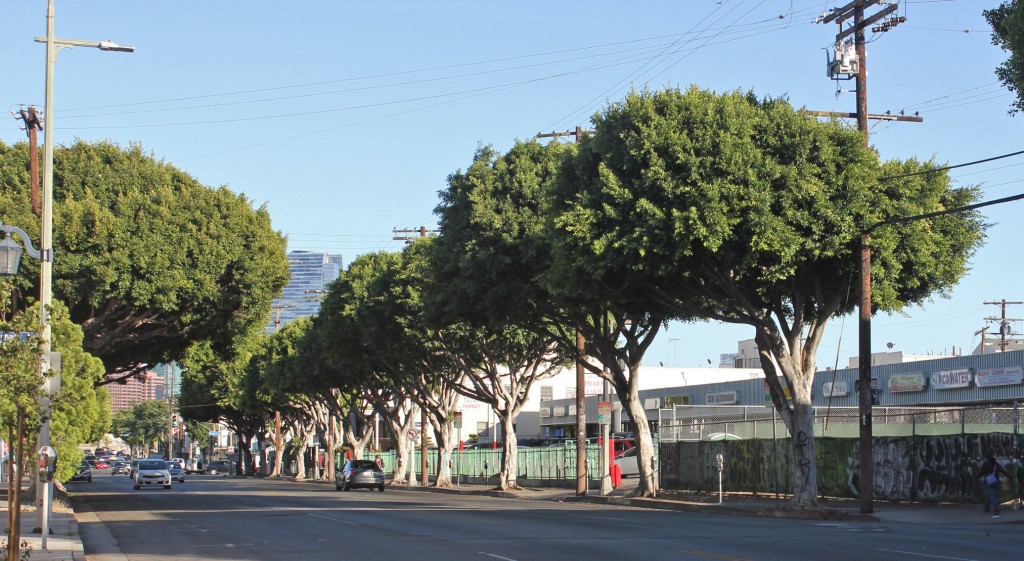
The goal of the grant KYCC received is to ensure half of the possible tree sites in South Los Angeles and Pico-Union are planted, creating consistent shade coverage. | Rachel Cohrs, Intersections South L.A.
One community organization has a grant to plant trees in South Los Angeles, but first it has to convince local residents that picturesque, tree-lined streets aren’t just for neighborhoods in Beverly Hills.
“If you’re struggling on a daily basis, trees might not be the first things you’re thinking about. These communities deal with crime, a large homeless population, illegally dumped trash, graffiti, and gang violence … Most people are just trying to get by,” said Ryan Allen, Environmental Services Manager of Koreatown Youth and Community Center (KYCC).
However, Allen and the staff at KYCC know that planting trees can have positive effects in low-income communities. The benefits of having densely planted trees include reduction of energy costs, creation of shade, and the beautification of neighborhoods.
In neighborhoods like South Los Angeles and Pico-Union, which both scored poorly in air quality evaluations, planting trees can help reduce the effects of pollution by removing toxins from the air.
“One tree on its own will do those things, but there is the idea of strength in numbers,” Allen said.
KYCC received nearly $330,000 in grant money from the California Department of Forestry and Fire Protection to make the vision of dense tree cover a reality in the South Los Angeles and Pico-Union areas.
The funds stem from a cap-and-trade program passed in California in 2006 to reduce greenhouse gas emissions. Under cap-and-trade, companies have to pay for emissions over a certain limit, increasing the incentive to reduce air pollution. At least 25 percent of the revenue from the program is distributed to greenhouse gas emissions-reducing projects in low-income neighborhoods.
South Los Angeles struggles with high levels of pollution that are compounded by other problems. A case study of the area shows that the South Los Angeles area is “disproportionately burdened” by poverty, unemployment and linguistic isolation.
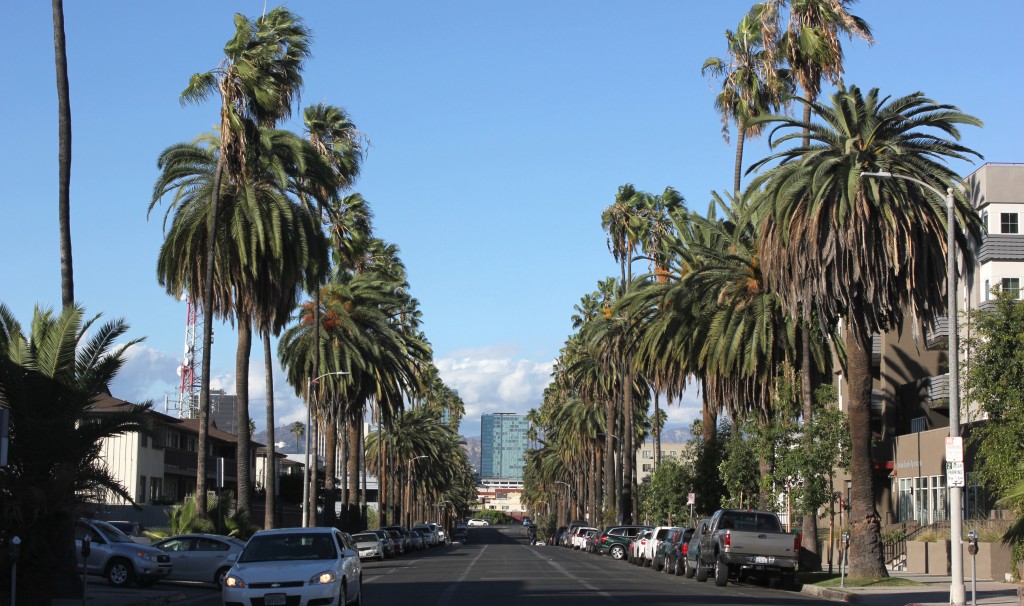
KYCC helped plant small trees between other trees to create shade cover on this street in South Los Angeles. | Rachel Cohrs, Intersections South L.A.
KYCC got the grant to plant 1,120 trees over a four-year period starting in 2016. Its goal in the project is to use the grant to see that at least half of the potential tree sites on neighborhood streets planted.
After the initial planting, KYCC will provide funding to maintain the trees for the first three years. After that, the trees will have grown substantially and will need less maintenance work. Despite the benefits of having trees planted, not everyone is on board with the plan.
Community members have voiced concerns about tree roots breaking up sidewalks, having to water, prune and maintain the trees, and the trees dropping leaves. Allen also cited a mental barrier that trees might not fit the culture of South Los Angeles neighborhoods. In the past, trees planted incorrectly caused sidewalks to crack and fall into disrepair.
That’s what the KYCC grant is for. Beyond buying trees to plant, the organization plans to reduce barriers and address community concerns. If community members voice worries, then KYCC can use some of the grant money to remove stumps or invasive trees, repair sidewalks, check sewer lines, and other incentives.
“We are going to try to address different concerns people could have so they don’t have reason to say no,” Allen said.
KYCC is qualified to mitigate these potential issues because the organization has been involved in tree planting efforts since 1999, and has expertise in selecting the right tree species and planting them in the right places to ensure they won’t damage sidewalks.
The task of physically getting the trees planted is expected to be an undertaking that will require community engagement. Previously, KYCC has gone door to door knocking and asking if residents would like a tree. The new grant is based on individuals taking responsibilities for their own streets and talking with their neighbors to get trees planted.
KYCC also plans to help organize community planting events to help get residents’ hands dirty and encourage involvement with the cause.
“It takes somebody dedicated, and a certain amount of legwork to work with neighborhood and to get people interested,” Allen said.
KYCC will be working through community organizations to streamline the process. Allen said the team is just now beginning to work with other organizations from existing partnerships and make new connections.
One new organization KYCC could be partnering with for a tree planting project on a different grant is the Redeemer Community Partnership.
Redeemer has an independent initiative focused on Jefferson Boulevard to “Make Jefferson Beautiful” by beginning a tree canopy, repairing sidewalks, and integrating bike lanes for safer transportation. Niki Wong, the lead community organizer at Redeemer Community Partnership, said she wants all the area surrounding USC to benefit from the university investment.
Tree cover on Jefferson on the USC side versus the community side
“USC is right next door. Vermont Avenue kind of serves as this invisible line between two cities….Part of what we are hoping to do is kind of dissolve that line and make the closeness beneficial for folks in the neighborhood,” Wong said.
Wong said one of the most important benefits of partnering with KYCC on a tree planting project is the commitment to long-term maintenance and community engagement. The grant Wong applied for through the Los Angeles Neighborhood Initiative would maintain 15 trees, plant 14 new trees, and replace two dead trees. Although the shade will not be provided immediately, within a few years well-tended trees will provide the full benefits.
Besides the environmental advantages of having trees planted, Wong also said attractive tree cover could encourage residents to go outside more and help draw businesses to the area.
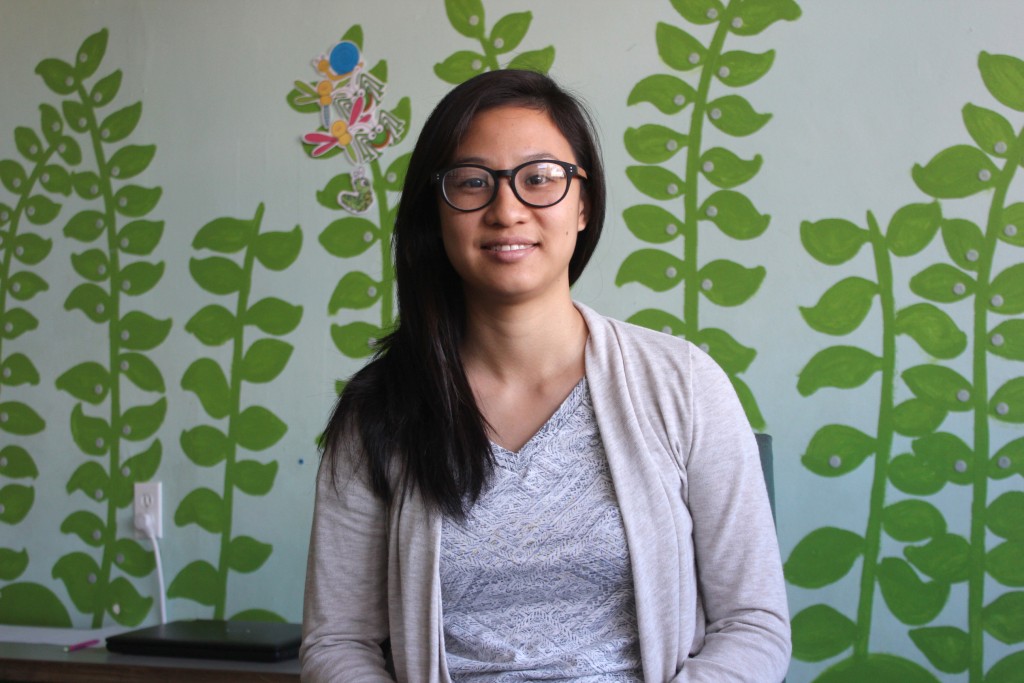
Niki Wong works with Redeemer Community Partnership to get grants to make Jefferson Boulevard safer and more beautiful. | Rachel Cohrs, Intersections South L.A.
Further, Wong pointed out that even though grant money is being set aside to help remedy these problems, under-resourced communities may not have the time or expertise to complete complicated grant application processes.
“This is for a community that has been overlooked, and at the bottom of the priority list for all sorts of improvements. Our crosswalks are faded, our sidewalks are broken, and a lot of tree wells are empty or have dead trees in them. It’s just very clear that there has been neglect,” Wong said.
Applications for annual grants will be available for the KYCC grant funds in the spring. Community organizations can apply and individuals can also get support to build up a tree canopy in South Los Angeles. Both Wong and Allen emphasized that in order to move forward with the projects, community support and engagement is essential.
“We want to be helping communities and residents to make their vision for a better neighborhood happen,” Allen said.
New Documentary ‘Can You Dig This’ Looks at Why Black Gardeners Matter + SoCal Gas May Take Months to Fix Ongoing Gas Leak in Porter Ranch
New Documentary ‘Can You Dig This’ Looks at Why Black Gardeners Matter
A new documentary looks at the story of four ‘unlikely gardeners’ in South L.A. whose lives were positively impacted after getting involved in the recent urban gardening phenomenon. The film comes shortly after a change in L.A.’s land-use policy, which now permits gardens in parkways. (Take Part)
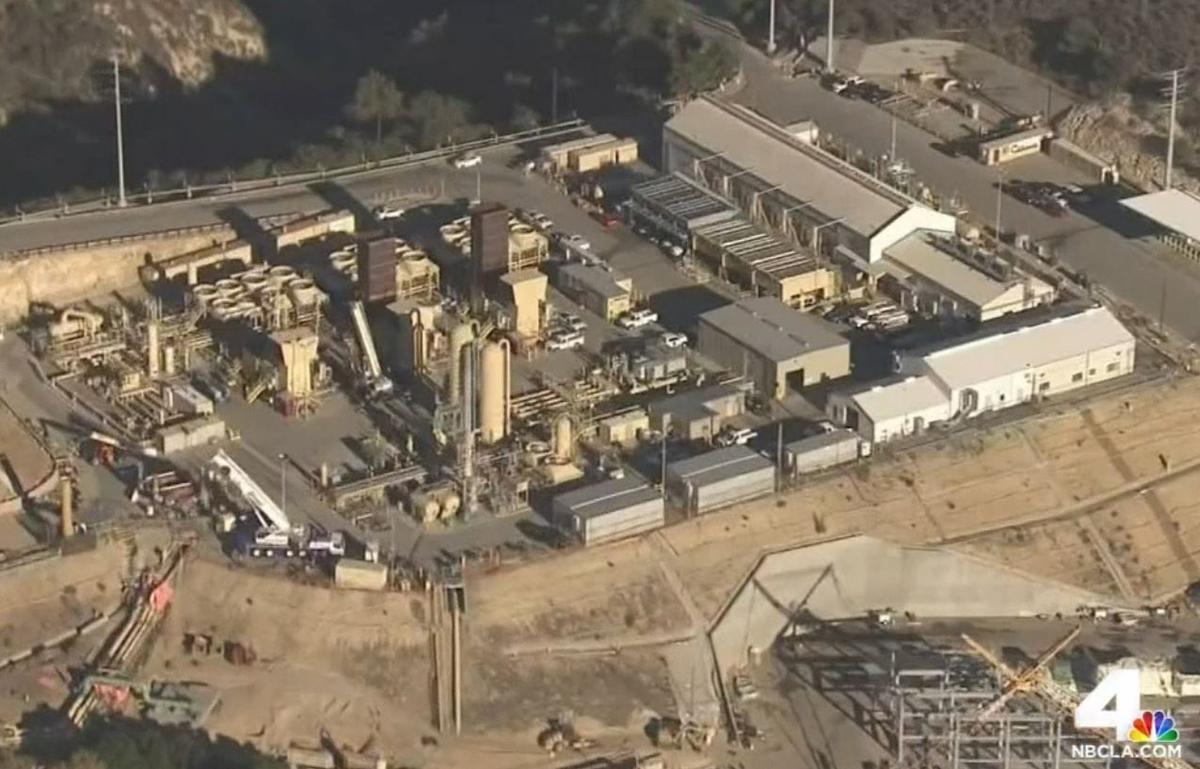
The chief executive of SoCal apologized to Porter Ranch residents about the ongoing gas leak causing a sickening smell in the community.
SoCal Gas May Take Months to Fix Ongoing Gas Leak in Porter Ranch
A methane gas leak from the Aliso Canyon storage facility in Porter Ranch is expected to take three to four months to complete. Impacted residents have been complaining for months about the bad odor, and have received an apology from the chief executive of the Southern California Gas Company. (ABC 7).
What happens when an aspiring teen chef from South L.A. meets the U.S. Surgeon General? + Did you buy a Powerball ticket in South LA? Claim your $866K prize!

Fremont High School senior Xiaxiang English served a chard-based salad to to the U.S. Surgeon General Friday. | Marisa Zocco, Intersections South L.A.
What happens when an aspiring teen chef from South L.A. meets the U.S. Surgeon General?
Fremont High School senior Xiaxiang English stood alongside U.S. Surgeon General Dr. Vivek Murthy on Friday, promoting nutrition and access to fresh fruits and vegetables as a preventive health measure. (Los Angeles Times)
Did you buy a Powerball Ticket in South LA? Claim your $866k prize!
The California Lottery announced Thursday that a winning lottery ticket purchased at a Florence neighborhood meat market in South L.A. remains unclaimed. (MyNewsLA.com)
Renata Simril to succeed Anita DeFrantz as head of LA84 Foundation
Former Dodger and LA Times executive Renata Simril was announced the CEO of LA84 Foundation on Wednesday. The foundation is endowed with 40 percent of the surplus of the 1984 Olympic Games and has funded more than $225 million in grants to support youth sports programs in Southern California. (MyNewsLA.com)
South LA youth, non-profits sue city over neighborhood oil drilling
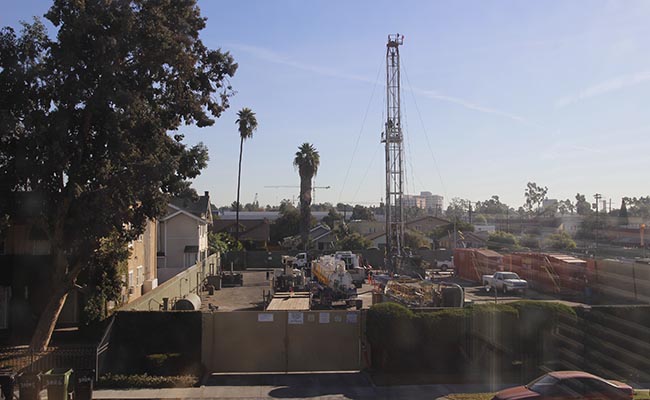
At its closest point, the Jefferson drill site is only three feet from homes. | Caitlyn Hynes, Intersections South L.A.
A few blocks west of the University of Southern California, behind ivy-covered walls, is the Jefferson oil-drilling site. The walls may block neighbors from seeing what goes on behind them, but they know, nonetheless.
Now, South Los Angeles youth, tired of living near toxic chemicals with little protection, are joining together with environmental non-profits to sue the city.
The Jefferson drilling site, owned and operated by Freeport-McMoran Inc., is one of the sites named in a lawsuit brought against the city. Located in the heart of a South Los Angeles neighborhood, the site is protected only by a retaining wall that neighbors say does little to contain the noise and odors produced by drilling. Other South L.A. sites face similar problems.
The plaintiffs in the lawsuit, the South Central Youth Leadership Coalition, Communities for a Better Environment, and the Center for Biological Diversity, held a press conference last Friday to announce the case. The groups allege that the city has not only violated regulations from the California Environmental Quality Act by issuing exemptions for environmental impact reports on oil drilling and production sites, but that it has also forced residents of color to bear disproportionate environmental and health burdens because of the lack of safety measures around several South Los Angeles sites.
Standing outside City Hall Friday with signs with that read, “Our health is not for sale” and, “Ain’t no power like the power of youth,” the minors stood behind speakers who demanded that the city comply with the California Environmental Quality Act by conducting environmental impact reports and providing better protection from, odors, toxins and noise pollution at the drilling sites.
“Our health and our environment are at risk. Community members should not have to jeopardize their health by simply being at home,” high school student Joshua Navarro told the press.
The lawsuit comes on the heels of an October audit that found that since 2007, most Los Angeles oil sites have not been subjected to an environmental impact report assessing the site’s health and environmental impacts on surrounding communities.
Reports from Al-Jazeera America found that the Jefferson drilling location is one of the sites lacking such documentation. It is currently unclear why these oversights have continued.
Protests and this lawsuit against oil companies have drawn the support of youth who live in the neighborhoods surrounding the Jefferson drill site. Many of the kids involved have lived around the site for years. They’ve smelled the chemicals and heard the loud sounds that often accompany drilling.
Elena Hume, 10, has been involved with several protests. She said she and her family would smell the chemicals as they went on walks around their neighborhood.
“I never knew it was an oil-drilling site. We’d see the bushes, and the rows of trees, and the big yellow gate,” Hume said. But now she knows what is happening and she feels it’s wrong to expose her neighborhood to the fumes of the toxic chemicals.
Jordan Parks, 12, has lived near the site his entire life. For a long time he and his family didn’t know exactly what was behind the walls. But when his father discovered it was an oil-drilling site, “Everyone started realizing how incredibly bad it was,” Jordan said.
Youth from the neighborhood around the Jefferson site, brought together by school, church and neighborhood tutoring programs, have become more involved in the issue through protests at the drilling site over the past few years.
Richard Parks, Jordan’s father, said that the kids were the ones who wanted to take action. He said the youth wanted to initiate the process because their homes and families were being directly affected.
A report from the National Resources Defense Council found that the chemicals used at oil drilling sites have been linked to cancer and other reproductive health problems. Neighbors have also blamed the site for headaches, nosebleeds and asthma.
Tanja Srebotnjak, a professor at Harvey Mudd College who has worked in oil and gas research for over fifteen years, said that the closer neighbors are to the chemicals used at oil drilling sites, the more susceptible they are to health complications.
“Farther is better and some states and municipalities have set distances ranging…up to 1,500 feet, 2,000 feet,” Srebotnjak said.
But a 2014 Community Health Councils study found that South L.A. drilling sites located in neighborhoods with high percentages of people of color were significantly closer to homes, schools and churches than sites in West L.A.
While the average distance from homes, schools and churches in South L.A. is 85 feet, the West L.A. and Wilshire sites, located in primarily white neighborhoods, are about 400 feet away.
Many West L.A. sites also have enclosed structures or some type of geographic barrier like a golf course that can help mitigate noise and odors. The Jefferson site, in contrast, has only a retaining wall as physical protection.
Niki Wong of Redeemer Community Partnership, a South L.A. non-profit that works in the neighborhood around the Jefferson drill site, estimated that the wells at the site are a mere 60 feet from homes, a distance that almost certainly exposes residents to toxins. Without an environmental impact report, it is hard to know exactly how the community would be affected if an explosion or other accident were to happen on the site.
Wong said that it is key to involve the youth of the neighborhood in this effort. “It’s important for them [to recognize] the need for a healthy and safe environment to grow up in.”
As for the kids around the Jefferson drill site, they say they just want their neighborhood to be safe for families. “It’d be nice if they just shut [the drilling site] down and turned it into a park or something, or more housing,” said Jordan.
The city attorney’s office told the Los Angeles Times that it will review the lawsuit.
SCLARC Opens New Headquarters + L.A. Extends Shelter Program for Homeless

South Central Los Angeles Regional Center Opens New Headquarters: South Central Los Angeles Regional Center (SCLARC), celebrated the grand opening of Legacy Plaza— the agency’s new headquarters — with a ribbon-cutting ceremony on Nov. 14. (Compton Herald)
L.A. to Extend Shelter Program for Homeless: With winter setting in and an El Nino weather pattern eyeing California, officials extended a campaign to help nearly 26,000 homeless people by opening public buildings as temporary shelters. (Fox News)
An Architectural Walking Tour of South L.A.’s Stately and Historic West Adams Boulevard:
South L.A.’s West Adams neighborhood is home to an array of architectural styles and several Historic-Cultural Monuments that have stood the test of time. Curbed LA mapped 13 of the neighborhood’s must-see spots that can be knocked out in a 2-mile stroll. (Curbed LA)
South LA youth sue the city + High winds sweep across LA

Los Angeles neighborhoods experienced high winds last weekend. (Caitlyn Hynes / Intersections South LA)
The sad, sickening truth about South L.A.’s oil wells: South LA youth are suing the city for unfairly exposing them to toxins found at oil drilling sites in the city. (Grist)
Los Angeles walloped by winds as cold front moves south: Los Angeles residents saw high wind speeds last weekend after a coldfront moved across the region. (KPCC)
NBC4 and Telemundo 52 Award $200,000 to Three Local South L.A. Nonprofits

Networks NBC4 Southern California and Telemundo 52 Los Angeles, in partnership with the NBCUniversal Foundation awarded three local nonprofits $200,000 as part of the 21st Century Solutions grant challenge.
The following organizations are this year’s recipients:
- A Place Called Home was awarded $100,000 for its “Nutrition and Urban Agriculture Program” addressing the lack of affordable and healthy fresh food options in South Los Angeles by engaging the whole family in gardening, meal preparation, nutrition and vocational training.
- Boys & Girls Club of West San Gabriel Valley was awarded $50,000 for its “Los Angeles STEM Initiative” created in partnership with East Los Angeles College provides comprehensive training in STEM to Boys & Girls Club staff, which is then taught to thousands of youth members.
- Clothes The Deal was awarded $50,000 for its “The Disabled Clothing Alterations Program” providing disabled veterans with business attire specifically altered for their physical disability.














